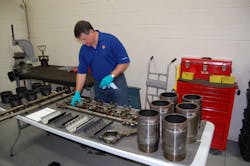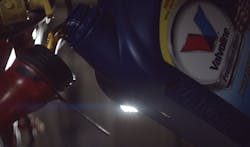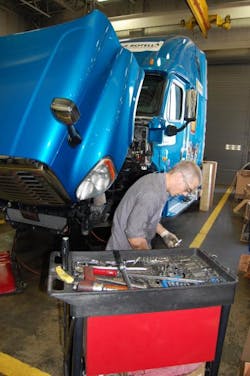Dan Arcy, the global OEM technical manager for the Americas for Shell Lubricants, that out of the three “phases” within the Proposed Category 11 or “PC-11” five-year development process that will result in the new CK-4 and FA-4 diesel engine motor oils on Dec. 1, the second phase proved to be the hardest and longest.
Starting in December 2011 and lasting until February 2016, the second phase of the PC-11 development process entailed the development of brand-new engine tests as well as the retirement of others.
“We knew we needed to look at three main areas of [oil] classification testing: oxidation control, aeration control, and shear stability,” he explained to Fleet Owner, and that entailed a lot of research.
“We looked at seven different tests for oxidation control alone,” Arcy pointed out, referencing the nine-member heavy-duty engine oil classification panel made up of engine manufacturer, chemical company, and oil marketer representatives who served under the auspices of the former American Society for Testing and Materials, now known as ASTM International.
Yet the work didn’t end when certain tests were selected by the panel, he stressed, for then they had to prove that results from the chosen test could be “repeatable” regardless of the laboratory used.“Using the same oil in the same test needed to give us the same result, Arcy explained. For example, in the case of the Volvo T-13 test selected to confirm oxidation control for PC-11 oils, it took “a couple of years” to get it established.
He noted that PC-11’s “phase two” work was largely completed by Dec. 2015, yet awaited a “final approval meeting” two months later with the American Petroleum Institute (API) to officially “sign off” on the testing results and classification standards.
With that final “seal of approval” in hand, the third and last phase of the PC-11 process began; one that ends Dec. 1 this year – the licensing and introduction of the new CK-4 and FA-4 blends to the market.
“There have been lots of little steps along the way” of phase three, Arcy emphasized, which includes labeling designs to help ensure customers pick the right oil for their engine.
“The product [PC-11] line is set to introduce new package labeling, bottle color and user friendly symbols to help customers choose with confidence and understand the enhanced benefits such as extended drain intervals, higher fuel economy or extreme temperature use they will receive,” noted Brian Humphrey, OEM technical liaison for Petro-Canada Lubricants.
“The API has released new service symbol ‘donuts’ which clearly distinguish between the two sub-categories,” he added. “However, oil marketers are allowed to use any color they choose for the donut itself. So we recommend visiting http://www.api.org/ to familiarize yourself with the different symbols before the Dec. 1 launch.”
Jeff Torkelson, technical director of engineering tech services with Valvoline, stressed that for the truck or fleet owner, the decision to use CK-4 or FA-4 will have to start with their OEM recommendations.“Some OEM’s will be recommending FA-4 for their new 2017 engines and some will not, so it’s important to pay close attention to your owner’s manual,” he emphasized to Fleet Owner. “Duty cycles may also play a role in selecting the correct category of lubricant, where severe service duty cycles are more likely to recommend using CK-4 oils versus FA-4.”
For fleets desiring to get every bit of fuel efficiency they can and if the OEM recommends FA-4 for their engine, then using it should result in improved fuel savings, Torkelson noted.
“Even with CK-4 backwards compatible oils, the 10W-30 grade should provide improved fuel efficiency compared to the 15W-40 grade,” he emphasized. “So for those looking for the best protection and durability, we recommend CK-4.”
While oil drain intervals will be set by the engine OEMs, Valvoline is expecting longer drain intervals for both CK-4 and FA-4. In fact, PACCAR is one such OEM that confirmed earlier this month that it will be extending oil drain intervals by 15,000 miles for its proprietary engine line.
“The increased robustness of the PC-11 oils could potentially allow longer drains,” Torkelson said. “The PC-11 category overall shows increased performance in oxidation protection, [plus] shear stability or stay-in-grade performance which could potentially result in longer drain intervals [and] reduced maintenance costs.”
He added that Valvoline has been working “diligently” on field testing PC-11 oil since the category need was announced and has been running longer and longer drain intervals with each prototype improvement.Those longer drains are the result of several factors, noted Shell’s Arcy, with the two main ones being less contamination of the oil and longer-lasting chemical additive packages.
“In terms of how far an oil can go, the viscosity or the ‘thinness’ of the oil does not make a difference,” he stressed. “A thicker CJ-4 15W-40 oil and FA-4 10W-30 oil could have the exact same [drain] interval. That’s because the [new] oils are designed to handle higher temperatures better and longer than [previous] oils and offer significantly better oxidation control.”
Like all the lubricant makers, Shell invested heavily in field tests for the new PC-11 oils – some 45 million miles worth across numerous truck duty cycles and engine displacements – which when added to the field tests conducted by the OEMs should give motor carriers “peace of mind” that the new oils perform as advertised.
“That’s a lot of miles and should give customers an extra sense of comfort,” Arcy said. “Because we all know customers won’t sacrifice durability for fuel economy.”
Knowing, however, that fleets often like to do their own validation tests, he offered a few suggestions:
- Use three to five trucks to get a good “statistical sampling” of your fleet’s operating characteristics;
- Use trucks with comparable load, route, and fuel economy characteristics;
- Use an oil analysis program;
- Conduct oil analysis tests on at least “a couple” or oil drains per truck, with each drain at anywhere from 40,000 to 60,000 miles.
About the Author
Sean Kilcarr
Editor in Chief
Sean Kilcarr is a former longtime FleetOwner senior editor who wrote for the publication from 2000 to 2018. He served as editor-in-chief from 2017 to 2018.



